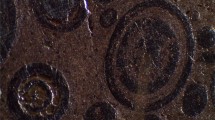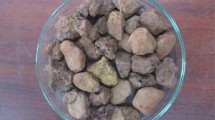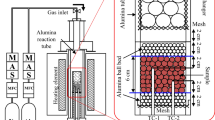Abstract
The chemical, physical, thermal and texture properties of iron ores from different regions of Odisha and Chhattisgarh regions, India, have been investigated to understand the compositional variations of Fe, Al2O3, SiO2, S and P. They were analyzed for its susceptibility to meet the industrial requirements, for various iron manufacture techniques. Chemical analysis indicated that the majority of the iron ores is rich in hematite (> 90 wt%), poor in gangue (<4.09 wt% SiO2 and <3.8 wt% Al2O3) and deleterious elements (P<0.065 wt% and S<0.016 wt%) in all these iron ores found to be low. XRD peaks reviled that the gangue is in the form of kaolinite and quartz, and same was observed in Fourier transform infrared (FTIR) spectroscopy in the range of 914 to 1034 cm–1. The iron ores were found to have excellent physical properties exemplify with tumbler index (82 wt%–91 wt%), abrasion index (1.27wt%–4.87 wt%) and shatter index (0.87wt%–1.64 wt%). FTIR and thermal analysis were performed to assimilate the analysis interpolations. It was found that these iron ores exhibit three endothermic reactions, which are dehydration below 447 K with mass loss of 0.13 wt% to 1.7 wt%, dehydroxylation at 525–609 K with mass loss of 1.09 wt%–4.49 wt% and decomposition of aluminosilicates at 597–850 K with mass loss of 0.13 wt%–1.15 wt%. From this study, we can conclude that due to its excellent physico-chemical characteristics, these iron ores are suitable for BF and DRI operations.
摘要
研究了印度奥里萨邦和恰蒂斯加尔邦不同地区铁矿石的化学、物理、热性能和结构特性,了解 了Fe、Al2O3、SiO2、S 和P 的组成变化,分析了其敏感性,以满足各种铁制造工业技术要求。化学 分析结果表明,大部分铁矿石中赤铁矿含量丰富(> 90 wt%),矸石含量低(<4.09 wt% SiO2,<3.8 wt% Al2O3),所有铁矿中有害元素含量低(P<0.065 wt%,S<0.016 wt%)。XRD 衍射表明矸石以高岭石和 石英的形式存在,其傅里叶变换红外光谱(FTIR)在914~1034 cm–1 范围内。该铁矿具有优良的物理 性能,例如转塔指数(82 wt%~91 wt%)、磨损指数(1.27 wt%~4.87 wt%)和破碎指数(0.87 wt%~1.64 wt%)。采用红外光谱和热分析方法对样品进行同化差值分析。研究表明,这些铁矿石具有三个吸热 反应,即低于447 K 的脱水反应,质量损失为0.13 wt%~1.7 wt%, 525~609 K 的脱羟基反应,质量损失 为1.09 wt%~4.49 wt%,597~850 K 的铝硅酸盐分解,质量损失为0.13 wt%~1.15 wt%。这些铁矿具有 优良的物理化学特性,适合高炉和DRI 作业。
Similar content being viewed by others
References
GOLDRING D C. Iron ore categorisation for the iron and steel industry [J]. Applied Earth Science, 2003, 112(1): 5–17. DOI: https://doi.org/10.1179/0371745032501162.
UPADHYAY R K, VENKATESH A S, ROY S. Mineralogical characteristics of iron ores in Joda and Khondbond areas in Eastern India with implications on beneficiation [J]. Resource Geology, 2010, 60(2): 203–211. DOI: https://doi.org/10.1111/j.1751-3928.2010.00126.x.
UPADHYAY R K, VENKATESH A S. Current strategies and future challenges on exploration, beneficiation and value addition of iron ore resources with special emphasis on iron ores from eastern India [J]. Applied Earth Science, 2006, 115(4): 187–95. DOI: https://doi.org/10.1179/174327506X13 8922.
SINHA M, NISTALA S H, CHANDRA S, MANKHAND T R. Mineralogy of iron ores of different alumina levels from Singhbhum belt and their implication on sintering process [J]. Journal of Minerals and Materials Characterization and Engineering, 2015, 3: 180–193. DOI: http://dx.doi.org/10.4236/jmmce.2015.33021.
MUWANGUZI A J, KARASEV A V, BYARUHANGA J K, JÖNSSON P G. Characterization of chemical composition and microstructure of natural iron ore from Muko deposits [J]. ISRN Materials Science, 2012, 3: 1–9. DOI: https://doi.org/10.5402/2012/147420.
KUMAR M, JENA S, PATEL S K. Characterization of properties and reduction behavior of iron ores for application in sponge ironmaking [J]. Mineral Processing and Extractive Metallurgy Review, 2007, 29(2): 118–29. DOI: https://doi.org/10.1080/08827500701421896.
CHOKSHI Y, LIMAYE M A, DUTTA S K, LODHARI D R. Mineralogical studies of low-grade iron ore from jharkhand–orissa region, india [J]. Transactions of the Indian Institute of Metals, 2016, 69(1): 151–155. DOI: https://doi.org/10.1007/s12666-015-0740-4.
RAO D S, KUMAR T V, RAO S S, PRABHAKAR S, RAJU G B. Mineralogy and geochemistry of a low grade iron ore sample from Bellary-hospet sector, India and their implications on beneficiation [J]. Journal of Minerals and Materials Characterization and Engineering, 2009, 8(2): 115–131. DOI: 10.4236/jmmce.2009.82011.
MAHIUDDIN S, BONDYOPADHWAY S, BARUAH J N. A study on the beneficiation of Indian iron-ore fines and slime using chemical additives [J]. International Journal of Mineral Processing, 1989, 26(3, 4): 285–296. DOI: https://doi.org/10.1016/0301-7516(89)90034-3.
LU L. Effects of alumina on sintering performance of hematite iron ores [J]. ISIJ International, 2007, 47(3): 349–358. DOI: https://doi.org/10.2355/isijinternational.47. 349.
CLOUT J M, MANUEL J R. Fundamental investigations of differences in bonding mechanisms in iron ore sinter formed from magnetite concentrates and hematite ores [J]. Powder Technology, 2003, 130(1): 393–399. DOI: https://doi.org/10.1016/S0032-5910(02)00241-3.
MAO Hong, ZHANG Ren, LV Xue, BAI Cheng, HUANG Xiao. Effect of surface properties of iron ores on their granulation behavior [J]. ISIJ International, 2013, 53(9): 1491–1496. DOI: https://doi.org/10.2355/isijinternational. 53.1491.
LADAVOS A K, KATSOULIDIS A P, IOSIFIDIS A, TRIANTAFYLLIDIS K S, PINNAVAIA T J, POMONIS P J. The BET equation, the inflection points of N2 adsorption isotherms and the estimation of specific surface area of porous solids [J]. Microporous and Mesoporous Materials, 2012, 151: 126–133. DOI: https://doi.org/10.1016/j.micromeso.2011.11.005.
LEOFANTI G, PADOVAN M, TOZZOLA G, VENTURELLI B. Surface area and pore texture of catalysts [J]. Catalysis Today, 1998, 41(1): 207–219. DOI: https://doi.org/10.1016/S0920-5861(98)00050-9.
DWECK J. Qualitative and quantitative characterization of Brazilian natural and organophilic clays by thermal analysis [J]. Journal of Thermal Analysis and Calorimetry, 2008, 92(1): 129–135. DOI: https://doi.org/10.1007/s10973-007-8751-y.
BOUCHARD M, MILLIARD A, RIVARD S, NESS S. ISO 9516–1 simplified borate fusion/WDXRF analytical method for iron ore including total iron analysis: Part 2. [J]. Powder Diffraction, 2014, 29(2): 170–175. DOI: https://doi.org/10.1017/S0885715614000323.
Indian Standard IS: 11690. Method of moisture determination of iron ore lot [S]. Bureau of Indian Standards, 1986: 1–12. DOI: https://archive.org/details/gov.in.is.11690. 1986.
Indian Standard IS: 6495. Method of tumbler test for iron oxides: Lump ores, sinter and pellet [S]. Bureau of Indian Standards, 1984: 1–8. DOI: https://archive.org/details/gov.in.is.6495.1984.
Indian Standard IS: 9963. Method of determination of shatter index of iron ore lumps, sinter and Pellets [S]. Bureau of Indian Standards, 1981: 1–6. DOI: https://archive.org/details/gov.in.is.9963.1981.
Indian Standard IS: 1528. Methods of sampling and physical tests for refractory materials [S]. Bureau of Indian Standards, 2010: 1–3. DOI: https://archive.org/details/gov. in.is.1528.7. 2010.
KANEKO K. Determination of pore size and pore size distribution: 1. Adsorbents and catalysts [J]. Journal of Membrane Science, 1994, 96(1, 2): 59–89. DOI: https://doi.org/10.1016/0376-7388(94)00126-X.
MCCANN G, STREZOV V, LUCAS J A, EVANS T, STREZOV L. Iron ore characterisation during high temperature thermal processing [J]. Asia-Pacific Journal of Chemical Engineering, 2004, 12(3, 4): 369–382. DOI: https://doi.org/10.1002/apj.5500120412.
FORMOSO A, MORO A, FERNÁNDEZ P G, MENÉNDEZ J L, MUNIZ M, CORES A. Influence of nature and particle size distribution on granulation of iron ore mixtures used in a sinter strand [J]. Ironmaking & Steelmaking. 2003, 30(6): 447–60. DOI: https://doi.org/10.1179/030192303225004187.
CLOUT J M F, MANUEL J R. Iron Ore: Mineralogy, processing and environmental sustainability [M]. Sawston, Cambridge: Woodhead Publishing, 2015: 45–84.
TSUKADA T, SEGAWA H, YASUMORI A, OKADA K. Crystallinity of boehmite and its effect on the phase transition temperature of alumina [J]. Journal of Materials Chemistry, 1999, 9(2): 549–53. DOI: 10.1039/A806728G.
BELLOTTO M, REBOURS B, EUZEN P. Mechanism of pseudo-boehmite dehydration: Influence of reagent structure and reaction kinetics on the transformation sequence [J]. Materials Science Forum, 1998, 278: 572–577. DOI: https://doi.org/10.4028/www.scientific.net/MSF.278-281.572.
CORES A, BABICH A, MUÑIZ M, ISIDRO A, FERREIRA S, MARTÍN R. Iron ores, fluxes and tuyere injected coals used in the blast furnace [J]. Ironmaking & Steelmaking, 2007, 34(3): 231–40. DOI: https://doi.org/10.1179/1743 28107X168066.
ULLAH R, DEB B K, MOLLAH M Y. Synthesis and characterization of silica coated iron-oxide composites of different ratios [J]. International Journal of Composite Materials, 2014, 4(2): 135–45. DOI: https://doi.org/10.5923/j.cmaterials.20140402.13.
SALAMA W, AREF M E L, GAUPP R. Spectroscopic characterization of iron ores formed in different geological environments using FTIR, XPS, Mössbauer spectroscopy and thermoanalyses [J]. Spectrochimica Acta Part A: Molecular and Biomolecular Spectroscopy, 2015, 136: 1816–1826. DOI: https://doi.org/10.1016/j.saa.2014.10.090.
SING K S. Adsorption methods for the characterization of porous materials [J]. Advances in colloid and interface science, 1998, 76: 3–11. DOI: https://doi.org/10.1016/s0001-8686(98)00038-4.
WEISSENBORN P K, DUNN J G, WARREN L J. Quantitative thermogravimetric analysis of haematite, goethite and kaolinite in Western Australian iron ores [J]. Thermochimica Acta, 1994, 239: 147–156. DOI: https://doi.org/10.1016/0040-6031(94)87063-2.
STREZOV V, ZIOLKOWSKI A, EVANS T J, NELSON P F. Assessment of evolution of loss on ignition matter during heating of iron ores [J]. Journal of Thermal Analysis and Calorimetry, 2010, 100(3): 901–907. DOI: https://doi.org/10.1007/s10973-009-0398-4.
ZERVAS T, MCMULLAN J T, WILLIAMS B C. Developments in iron and steel making [J]. International journal of energy research, 1996, 20(1): 69–91. DOI: https://doi.org/10.1002/(SICI)1099-114X(199601)20:1<69::AIDER241> 3.0.CO;2-3.
DE LIMA L C, DUARTE J B, VEZIROGLU T N. A proposal of an alternative route for the reduction of iron ore in the eastern Amazonia [J]. International Journal of Hydrogen Energy, 2004, 29(6): 659–661. DOI: https://doi.org/10.1016/S0360-3199(03)00053-3.
MICHISHITA H, TANAKA H. Prospects for coal-based direct reduction process [J]. Kobelco Technology Review, 2010, 29: 69–76. DOI: http://www.kobelco.co.jp/english/ktr/pdf/ktr_29/whole.pdf.
BEDARKAR S S, SINGH R. Removal of phosphorous from steel produced by melting sponge iron in induction furnace [J]. Transactions of the Indian Institute of Metals, 2013, 66(3): 207–211. DOI: https://doi.org/10.1007/s12666-013-0244-z.
Author information
Authors and Affiliations
Corresponding author
Additional information
Foundation item: Project supported by the National Institute of Technology, Rourkela, India
Rights and permissions
About this article
Cite this article
Kotta, A.B., Karak, S.K. & Kumar, M. Chemical, physical, thermal, textural and mineralogical studies of natural iron ores from Odisha and Chhattisgarh regions, India. J. Cent. South Univ. 25, 2857–2870 (2018). https://doi.org/10.1007/s11771-018-3958-6
Received:
Accepted:
Published:
Issue Date:
DOI: https://doi.org/10.1007/s11771-018-3958-6




